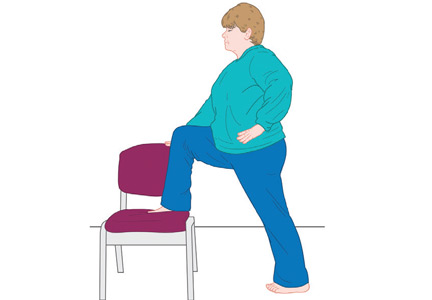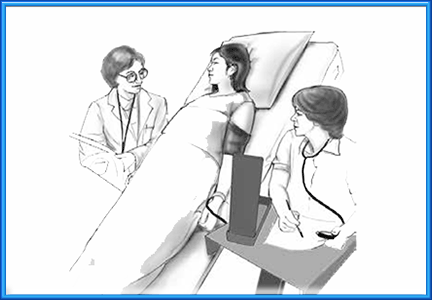User login
EEG Basics
Obesity and exercise
Obesity means having a body mass index (BMI) of 30 or higher. Being obese increases your risk of health problems including high blood pressure, diabetes, cholesterol, arthritis, cancer, and cardiovascular diseases such as stroke and heart attack. You can reduce these risks by losing weight.
The healthy way to lose weight is to eat fewer calories, eat less processed food and more whole foods, and exercise regularly. A dietitian can help you create a flexible and balanced eating plan to help you meet your goals.
When beginning an exercise plan, start slowly with a combination of aerobic, resistance, flexibility, and balance exercises. A combined aerobic and resistance exercise program will likely result in more weight loss than either alone.
Aerobic exercises should be the foundation of your program. Choose exercises that involve large muscle groups, such as walking. Walking is the easiest way for most people to start exercising, but you can also consider other exercises such as stationary bicycling, slow jogging, and water aerobics.
Resistance training involves lifting weights using either weight machines or free weights (dumbbells).
Flexibility exercises are a type of stretching that improves the movements of your muscles, joints, and ligaments.
Balance exercises improve your stability and reduce the chance of falling or other injuries. These exercises can be done without any equipment. For example, with single-leg balance, you balance on one foot for 15 seconds. A stand-sit involves standing up and sitting down without using your hands.
Your provider will design an exercise program for you that includes the frequency, intensity, time, and types of exercise. Typically, you’ll want to lose about 10% of your weight over a 6-month period. Be sure to set SMART goals (Specific, Measurable, Attainable, Realistic, Timely) to sustain the self-discipline required for long-term success. Also consider tracking your physical activity using a wearable device (eg, Fitbit) or a smartphone app. It lets you see your progress over time, helps you set new goals, and helps keep you motivated.
This information is provided by your physician and the Cleveland Clinic Journal of Medicine. It is not designed to replace a physician’s medical assessment and judgment.
This page may be reproduced noncommercially to share with patients. Any other reproduction is subject to Cleveland Clinic Journal of Medicine approval. Bulk color reprints available by calling 216-444-2661.
For patient information on hundreds of health topics, visit the Center for Consumer Health Information website, www.clevelandclinic.org/health.
Obesity means having a body mass index (BMI) of 30 or higher. Being obese increases your risk of health problems including high blood pressure, diabetes, cholesterol, arthritis, cancer, and cardiovascular diseases such as stroke and heart attack. You can reduce these risks by losing weight.
The healthy way to lose weight is to eat fewer calories, eat less processed food and more whole foods, and exercise regularly. A dietitian can help you create a flexible and balanced eating plan to help you meet your goals.
When beginning an exercise plan, start slowly with a combination of aerobic, resistance, flexibility, and balance exercises. A combined aerobic and resistance exercise program will likely result in more weight loss than either alone.
Aerobic exercises should be the foundation of your program. Choose exercises that involve large muscle groups, such as walking. Walking is the easiest way for most people to start exercising, but you can also consider other exercises such as stationary bicycling, slow jogging, and water aerobics.
Resistance training involves lifting weights using either weight machines or free weights (dumbbells).
Flexibility exercises are a type of stretching that improves the movements of your muscles, joints, and ligaments.
Balance exercises improve your stability and reduce the chance of falling or other injuries. These exercises can be done without any equipment. For example, with single-leg balance, you balance on one foot for 15 seconds. A stand-sit involves standing up and sitting down without using your hands.
Your provider will design an exercise program for you that includes the frequency, intensity, time, and types of exercise. Typically, you’ll want to lose about 10% of your weight over a 6-month period. Be sure to set SMART goals (Specific, Measurable, Attainable, Realistic, Timely) to sustain the self-discipline required for long-term success. Also consider tracking your physical activity using a wearable device (eg, Fitbit) or a smartphone app. It lets you see your progress over time, helps you set new goals, and helps keep you motivated.
This information is provided by your physician and the Cleveland Clinic Journal of Medicine. It is not designed to replace a physician’s medical assessment and judgment.
This page may be reproduced noncommercially to share with patients. Any other reproduction is subject to Cleveland Clinic Journal of Medicine approval. Bulk color reprints available by calling 216-444-2661.
For patient information on hundreds of health topics, visit the Center for Consumer Health Information website, www.clevelandclinic.org/health.
Obesity means having a body mass index (BMI) of 30 or higher. Being obese increases your risk of health problems including high blood pressure, diabetes, cholesterol, arthritis, cancer, and cardiovascular diseases such as stroke and heart attack. You can reduce these risks by losing weight.
The healthy way to lose weight is to eat fewer calories, eat less processed food and more whole foods, and exercise regularly. A dietitian can help you create a flexible and balanced eating plan to help you meet your goals.
When beginning an exercise plan, start slowly with a combination of aerobic, resistance, flexibility, and balance exercises. A combined aerobic and resistance exercise program will likely result in more weight loss than either alone.
Aerobic exercises should be the foundation of your program. Choose exercises that involve large muscle groups, such as walking. Walking is the easiest way for most people to start exercising, but you can also consider other exercises such as stationary bicycling, slow jogging, and water aerobics.
Resistance training involves lifting weights using either weight machines or free weights (dumbbells).
Flexibility exercises are a type of stretching that improves the movements of your muscles, joints, and ligaments.
Balance exercises improve your stability and reduce the chance of falling or other injuries. These exercises can be done without any equipment. For example, with single-leg balance, you balance on one foot for 15 seconds. A stand-sit involves standing up and sitting down without using your hands.
Your provider will design an exercise program for you that includes the frequency, intensity, time, and types of exercise. Typically, you’ll want to lose about 10% of your weight over a 6-month period. Be sure to set SMART goals (Specific, Measurable, Attainable, Realistic, Timely) to sustain the self-discipline required for long-term success. Also consider tracking your physical activity using a wearable device (eg, Fitbit) or a smartphone app. It lets you see your progress over time, helps you set new goals, and helps keep you motivated.
This information is provided by your physician and the Cleveland Clinic Journal of Medicine. It is not designed to replace a physician’s medical assessment and judgment.
This page may be reproduced noncommercially to share with patients. Any other reproduction is subject to Cleveland Clinic Journal of Medicine approval. Bulk color reprints available by calling 216-444-2661.
For patient information on hundreds of health topics, visit the Center for Consumer Health Information website, www.clevelandclinic.org/health.
Common Misconceptions of Seizures and Epilepsy
Click here for a partial list of common questions and assumptions that individuals who are newly diagnosed with epilepsy or seizures may have.
Click here for a partial list of common questions and assumptions that individuals who are newly diagnosed with epilepsy or seizures may have.
Click here for a partial list of common questions and assumptions that individuals who are newly diagnosed with epilepsy or seizures may have.
Tips for Seniors With Epilepsy -- Avoiding Falls
Tips for Minimizing Recurrence of Seizures
Focus on Seizures
Seizure Safety Tips
Epilepsy Basics
Tilt-table testing
Fainting, also called syncope (pronounced “SIN-ko-pea”), is caused by a temporary decrease in blood flow to the brain. If you have syncope, your doctor may order a tilt-table test to determine why the blood flow is decreased and how to treat it. The purpose of the test is not to make you faint, although some people do faint during the test.
What happens before the test?
An intravenous line will be placed in a vein in your arm or the back of your hand. It may be used to take blood samples and also to give medications (if you need them) during the test.
Blood pressure cuffs will be placed around both arms, and small, sticky patches called electrodes will be placed on your chest. The electrodes are connected to a monitor that shows your heart’s rate and rhythm.
What happens during the test?
You will lie on a motorized table with a metal footboard. For your safety, soft straps will be placed across your body to secure you when the table is tilted during the test. Your blood pressure and heart rate will be constantly monitored. You will be asked to remain as still and quiet as possible so that the results can be accurately recorded.
A nurse or technician will tilt the table to different angles during the test—30 degrees for 2 minutes, then 45 degrees for 2 minutes, and then 70 degrees for up to 45 minutes. You will always be “head up”; you will never be upside-down. When the table is at 30 and 45 degrees, you will feel as if you are lying on a steep hill. When it is at 70 degrees, you will be in an upright position and your feet will be supported by the footboard at the end of the table.
How long will the test last?
About 1½ hours—plan on being at the hospital for about 2 hours total. You will need a responsible adult to drive you home.
Should I take my medications?
Yes. You can take your prescription medications as you normally would, with water. However, do not take diuretics or laxatives before the test.
If you have questions or need help adjusting your medications, please call your physician. Do not discontinue any medication without talking to your physician first.
Can I eat before the test?
Eat a normal meal the evening before your procedure. Do not eat or drink anything except small amounts of water for 4 hours before the test. If you must take medications, please take them with small sips of water.
If you have diabetes, please request a 10:30 am appointment time for your test so you can eat a light breakfast before 7 am and also complete the test in time for lunch.
What do the test results mean?
A positive test means that you may have a condition that causes an abnormal change in blood pressure or heart rate when you stand up. A negative test means that you did not show signs of such a condition. In either case, additional tests may be needed to diagnose your condition.
This information is provided by your physician and the Cleveland Clinic Journal of Medicine. It is not designed to replace a physician’s medical assessment and judgment.
This page may be reproduced noncommercially to share with patients. Any other reproduction is subject to Cleveland Clinic Journal of Medicine approval. Bulk color reprints available by calling 216-444-2661.
For patient information on hundreds of health topics, see the Center for Consumer Health Information web site, www.clevelandclinic.org/health
Fainting, also called syncope (pronounced “SIN-ko-pea”), is caused by a temporary decrease in blood flow to the brain. If you have syncope, your doctor may order a tilt-table test to determine why the blood flow is decreased and how to treat it. The purpose of the test is not to make you faint, although some people do faint during the test.
What happens before the test?
An intravenous line will be placed in a vein in your arm or the back of your hand. It may be used to take blood samples and also to give medications (if you need them) during the test.
Blood pressure cuffs will be placed around both arms, and small, sticky patches called electrodes will be placed on your chest. The electrodes are connected to a monitor that shows your heart’s rate and rhythm.
What happens during the test?
You will lie on a motorized table with a metal footboard. For your safety, soft straps will be placed across your body to secure you when the table is tilted during the test. Your blood pressure and heart rate will be constantly monitored. You will be asked to remain as still and quiet as possible so that the results can be accurately recorded.
A nurse or technician will tilt the table to different angles during the test—30 degrees for 2 minutes, then 45 degrees for 2 minutes, and then 70 degrees for up to 45 minutes. You will always be “head up”; you will never be upside-down. When the table is at 30 and 45 degrees, you will feel as if you are lying on a steep hill. When it is at 70 degrees, you will be in an upright position and your feet will be supported by the footboard at the end of the table.
How long will the test last?
About 1½ hours—plan on being at the hospital for about 2 hours total. You will need a responsible adult to drive you home.
Should I take my medications?
Yes. You can take your prescription medications as you normally would, with water. However, do not take diuretics or laxatives before the test.
If you have questions or need help adjusting your medications, please call your physician. Do not discontinue any medication without talking to your physician first.
Can I eat before the test?
Eat a normal meal the evening before your procedure. Do not eat or drink anything except small amounts of water for 4 hours before the test. If you must take medications, please take them with small sips of water.
If you have diabetes, please request a 10:30 am appointment time for your test so you can eat a light breakfast before 7 am and also complete the test in time for lunch.
What do the test results mean?
A positive test means that you may have a condition that causes an abnormal change in blood pressure or heart rate when you stand up. A negative test means that you did not show signs of such a condition. In either case, additional tests may be needed to diagnose your condition.
This information is provided by your physician and the Cleveland Clinic Journal of Medicine. It is not designed to replace a physician’s medical assessment and judgment.
This page may be reproduced noncommercially to share with patients. Any other reproduction is subject to Cleveland Clinic Journal of Medicine approval. Bulk color reprints available by calling 216-444-2661.
For patient information on hundreds of health topics, see the Center for Consumer Health Information web site, www.clevelandclinic.org/health
Fainting, also called syncope (pronounced “SIN-ko-pea”), is caused by a temporary decrease in blood flow to the brain. If you have syncope, your doctor may order a tilt-table test to determine why the blood flow is decreased and how to treat it. The purpose of the test is not to make you faint, although some people do faint during the test.
What happens before the test?
An intravenous line will be placed in a vein in your arm or the back of your hand. It may be used to take blood samples and also to give medications (if you need them) during the test.
Blood pressure cuffs will be placed around both arms, and small, sticky patches called electrodes will be placed on your chest. The electrodes are connected to a monitor that shows your heart’s rate and rhythm.
What happens during the test?
You will lie on a motorized table with a metal footboard. For your safety, soft straps will be placed across your body to secure you when the table is tilted during the test. Your blood pressure and heart rate will be constantly monitored. You will be asked to remain as still and quiet as possible so that the results can be accurately recorded.
A nurse or technician will tilt the table to different angles during the test—30 degrees for 2 minutes, then 45 degrees for 2 minutes, and then 70 degrees for up to 45 minutes. You will always be “head up”; you will never be upside-down. When the table is at 30 and 45 degrees, you will feel as if you are lying on a steep hill. When it is at 70 degrees, you will be in an upright position and your feet will be supported by the footboard at the end of the table.
How long will the test last?
About 1½ hours—plan on being at the hospital for about 2 hours total. You will need a responsible adult to drive you home.
Should I take my medications?
Yes. You can take your prescription medications as you normally would, with water. However, do not take diuretics or laxatives before the test.
If you have questions or need help adjusting your medications, please call your physician. Do not discontinue any medication without talking to your physician first.
Can I eat before the test?
Eat a normal meal the evening before your procedure. Do not eat or drink anything except small amounts of water for 4 hours before the test. If you must take medications, please take them with small sips of water.
If you have diabetes, please request a 10:30 am appointment time for your test so you can eat a light breakfast before 7 am and also complete the test in time for lunch.
What do the test results mean?
A positive test means that you may have a condition that causes an abnormal change in blood pressure or heart rate when you stand up. A negative test means that you did not show signs of such a condition. In either case, additional tests may be needed to diagnose your condition.
This information is provided by your physician and the Cleveland Clinic Journal of Medicine. It is not designed to replace a physician’s medical assessment and judgment.
This page may be reproduced noncommercially to share with patients. Any other reproduction is subject to Cleveland Clinic Journal of Medicine approval. Bulk color reprints available by calling 216-444-2661.
For patient information on hundreds of health topics, see the Center for Consumer Health Information web site, www.clevelandclinic.org/health

















